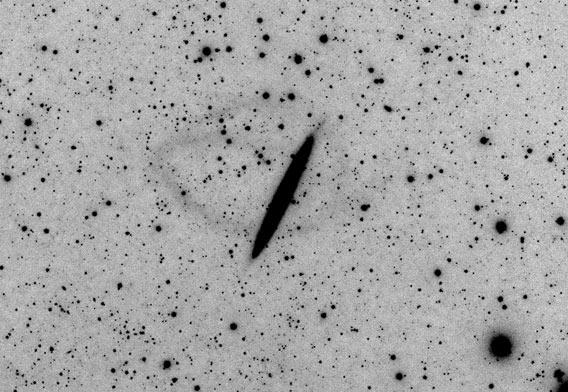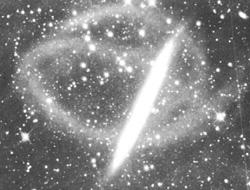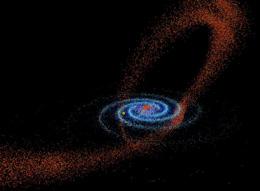Spiral galaxies have an interesting property: They’re flat. When you see them face-on, you can take in their full spirally goodness. But if they happen to be oriented edge-on to us, they can look nearly as thin as a knife’s edge.
NGC 5907 is a great example of that. Located roughly 40 million light years away—fairly close by as galaxies go—it is very nearly sideways with respect to us, and so thin it was given the nickname “The Splinter Galaxy”:

Image credit: Patrick Hochleitner and Dieter Beer
That shot was not taken using some gigantic professional observatory. It was taken using—and this really is incredible—a 120mm (5”) telescope! Astrophotographers Patrick Hochleitner and Dieter Beer took it, using a DSLR camera and a special astrophotography camera. They combined a total of 129 separate images to make a single shot that was the equivalent of a 23 hour 25 minute exposure: nearly an entire day.
The image is revealing. You can see how flat NGC 5907 is, and also see the dark filigree across its middle that’s composed of countless clouds of interstellar dust. What struck me right away is something that’s missing: a bulge in the middle. Most spiral galaxies have a spherical hub of stars surrounding their cores, but NGC 5907’s is weak at best.
But this galaxy is even more amazing than you can see in this image. Beer and Hochleitner took all their images, added them together without color information, and then inverted them so that black is white and vice-versa. This allows fainter detail to be seen, and allows this otherwise lovely but mundane galaxy to suddenly reveal a deep, faint secret:

Image credit: Patrick Hochleitner and Dieter Beer
Look at that! It’s surrounded by a faint ribbon of…something. You can’t tell in this image, but deep imaging by larger telescopes has revealed that this loop-de-loop is actually made of stars. It’s technically called a tidal stream, a river of stars orbiting the central galaxy in a gigantic flow hundreds of thousands of light years long.
What the heck can do that?

Image credit: David Martınez-Delgado et al.
There are two (related) ways to generate this ribbon of stars. One is cannibalism: a small companion galaxy, a satellite to the big galaxy, is on an orbit that takes it through the disk of the galaxy and out the other side. Repeated passes through the big galaxy strip the gas and dust from the smaller one, and the gravity of the big galaxy rips the stars out over time as well, disrupting it. Over hundreds of millions of years you get this long ribbon wrapped around the galaxy.
Another way is to create a tidal stream is with a major merger: when two galaxies of approximately equal size interact gravitationally and eventually merge together into one bigger galaxy. That can eject a stream of stars that looks quite a bit like this as well.
The difference between the two scenarios—small galaxy versus big one getting eaten—may seem trivial, but in fact predicts different eventual outcomes. For example, a small galaxy should leave a small, dense core of stars that is held together more tightly by gravity, and is therefore harder to rip asunder. No such core is seen here. However, big mergers generally create a lot more chaos, but NGC 5907 looks fairly serene (though, to be fair, a tidal stream can last for over a billion of years, plenty of time for the sound and fury of a merger to quiet down).

Image credit: Steve Majewski et al.
The bottom line is that we’re not exactly sure which of these two scenarios played out here. And we’d like to know, since we think all big galaxies, including our own Milky Way, grew to their current size by either eating smaller galaxies or merging with big ones. We have plenty of evidence for that, including a tidal stream very similar to NGC 5907’s seen in our own galaxy, caused by the Milky Way eating what’s called the Sagittarius dwarf galaxy!
And there’s more: we’re on a collision course ourselves. In a few billion years, the Andromeda galaxy will collide with and merge into the Milky Way. Both galaxies are pretty beefy, among the largest galaxies in the Universe, so when we’re done we’ll be even heftier.
Galaxies are a perfect example of the irony of what looks like stately, serene beauty actually being due to incredibly violent acts (in this case wanton cannibalism and cosmic train wrecks). And you don’t need a huge telescope to peer into the vasty depths of the Universe to see it either; it happens right in our neighborhood, and even in our own house.
Tip o’ the fava bean with a nice Chianti to Dieter Beer on Facebook.